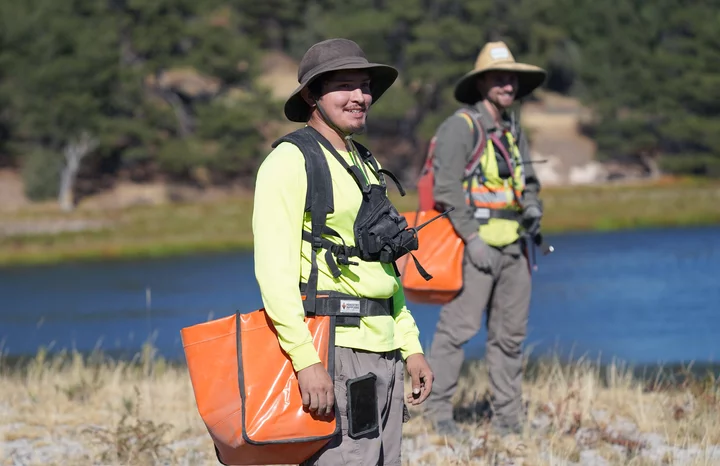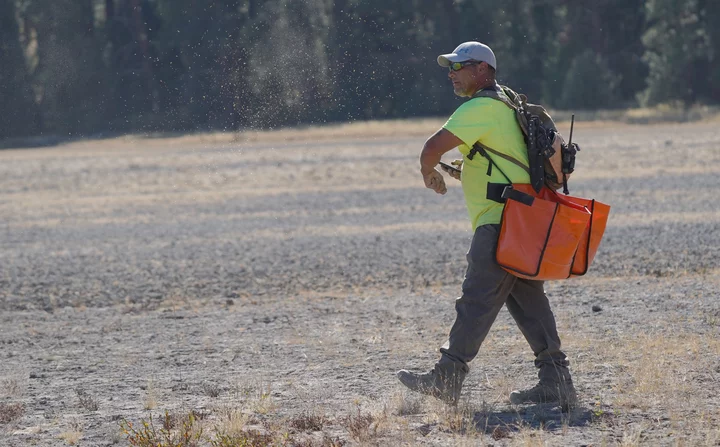Yurok Fisheries Department Revegetation Crew Members Spe-gi Vigil and Miles Brooks sow a specialized blend of 20 native plants seeds along the recently undammed Klamath River. | Photos courtesy the Yurok Tribe.
###
Press release from the Yurok Tribe:
Building on the success of the winter planting, the Yurok Tribe’s Fisheries Department Revegetation Crew initiated phase two of a massive revegetation project along the recently undammed segment of river this week as salmon migrate to the Upper Klamath Basin for the first time in more than a century.
The Yurok Revegetation Crew, under contract with Resource Environmental Solutions, is hand sowing millions of native plant seeds in the former J.C. Boyle Reservoir, where a band of lush flora lines the now free-flowing river. Custom curated by Yurok Fisheries Department Senior Riparian Biologist Joshua Chenoweth, the planting includes specialized blends of dozens of mutually beneficial native plant species that flourished along the Upper Klamath before the dams and colonization.
“On the first morning, we saw an otter, eagles and waterfowl on the river’s edge. I wouldn’t be surprised if we see a few salmon move through there soon,” said longtime Yurok Revegetation Crew member Ben Hunsucker, a Yurok citizen. “I know our ancestors are proud of the work we are doing on behalf of the river.”
The primary goal of the years-long revegetation effort is to establish interconnected biologically diverse ecosystems that support strong salmon, steelhead and Pacific lamprey populations. The project is already yielding positive results. Much of the reservoir reach is covered in soil-stabilizing vegetation, now dormant because it’s the dry season. Hand sown this winter, countless native flowers bloomed from March to October, enticing pollinators to recolonize the area. The seam of green vegetation next to the river is humming with insects that serve as a primary food source for juvenile salmon, steelhead and resident trout. Oregon white oak (Quercus garryana), ponderosa pine (Pinus ponderosa) and Fremont cottonwood (Populus fremontii) saplings are digging deep roots as are perennial bunchgrasses like Blue wildrye (Elymus glaucus).
“I’m happy with the volume and diversity of healthy plants that we are seeing right now. It bodes well for the future,” said Chenoweth, who led the post dam removal revegetation work on the Elwha River before spending five years planning the Klamath project.
On October 2, the in-river portion of the Klamath dam removal project concluded. Largely responsible for a 95 percent decline in the river’s salmon stocks, the dams blocked 400 miles of historic fish habitat, degraded water quality and increased the prevalence of deadly fish pathogens. The Yurok Tribe and many other tribes in the Klamath Basin spent decades fighting for the removal of the dams and the restoration of the river. Last Thursday, fisheries researchers detected the first salmon to travel above the former Iron Gate dam site.
More good news for the Klamath
The Yurok Tribe recently received $18 million from NOAA for the Upper Klamath River Tributary Post Dam Removal Salmonid Restoration Project. Focused on stream reaches outside of the reservoir footprints, the project seeks to restore Shovel Creek and sections of other tributaries between Jenny Creek in California and Spencer Creek in Oregon. The Yurok Tribe-led project will create approximately 150 acres of optimal fish and wildlife habitat through fish passage improvements, floodplain reconnection, side channel construction and stream habitat diversification. Currently, the Yurok Fisheries Department is working with four upper basin tribes and two conservation organizations to design the five-year undertaking.
The tributary restoration project will complement the ongoing revegetation initiative in the reservoir reach. In January, the Yurok revegetation team planted more than 16,000 pounds of native grass, herb and forb seed mixes throughout the reservoir reach. The crew also manually planted 76,000 trees, shrubs and bunch grass plugs, 25,000 acorns and 2,500 narrowleaf milkweed starts. This spring, the reservoir erupted into a sea of wildflowers. In fact, certain plant species like Yellow Gum Plant (Grindella camporum) are presently blooming alongside baby pine trees above the J.C. Boyle dam site. Many more seeds, trees, shrubs and grasses will be planted next spring.
###
Yurok Fisheries Department
The Yurok Fisheries Department employs more biologists than any other agency in California aside from the state Department of Fish and Wildlife. With nearly 100 employees, the department is comprised of the following six major Programs: Harvest Management Program (engages in all aspects of fishery harvest management and monitors the Yurok fishery); Lower Klamath Program (conducts research, monitoring, and restoration of fisheries resources in the Lower Klamath River Sub-basin); Trinity River Program (conducts research, monitoring, and restoration of Trinity River fishery resources); Klamath River Program (conducts research and monitoring throughout the watershed with a focus on informing water management and policy); Technical Services Program (provides data collection and analyses, designs and implements large scale restoration projects throughout the region); Water Policy Program (provides analyses and information to Tribal leadership regarding all aspects of Klamath Basin water policy and water management issues).
Yurok Fisheries Department Revegetation Crew Member Ben Hunsucker sows a unique blend of 20 native plant seeds above the newly freed Klamath River.


CLICK TO MANAGE